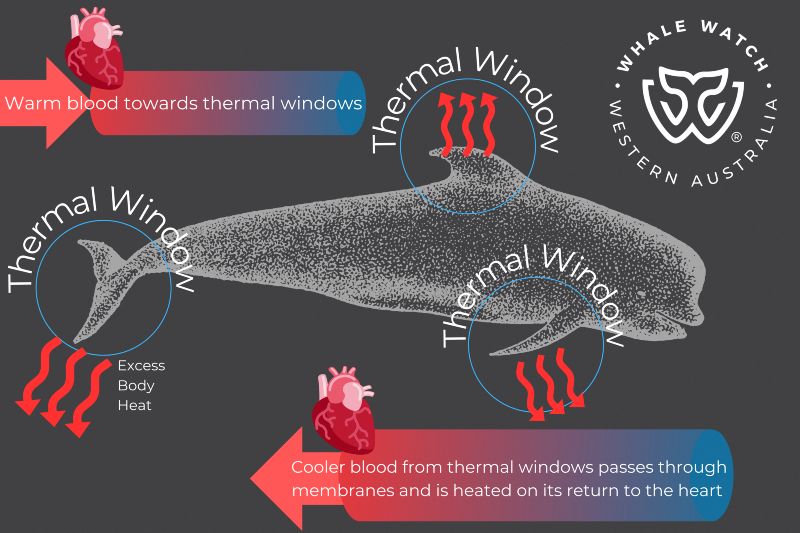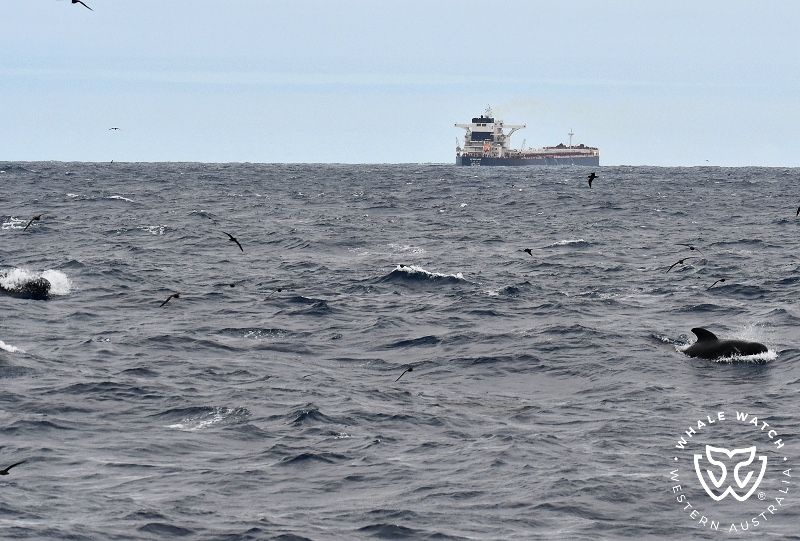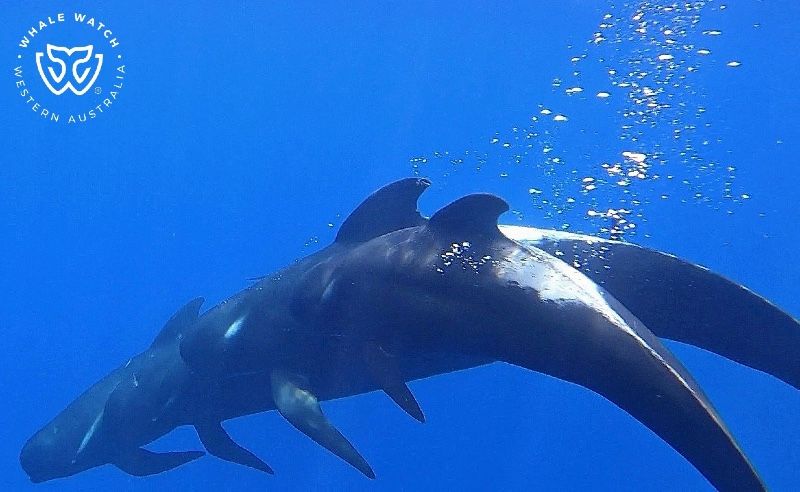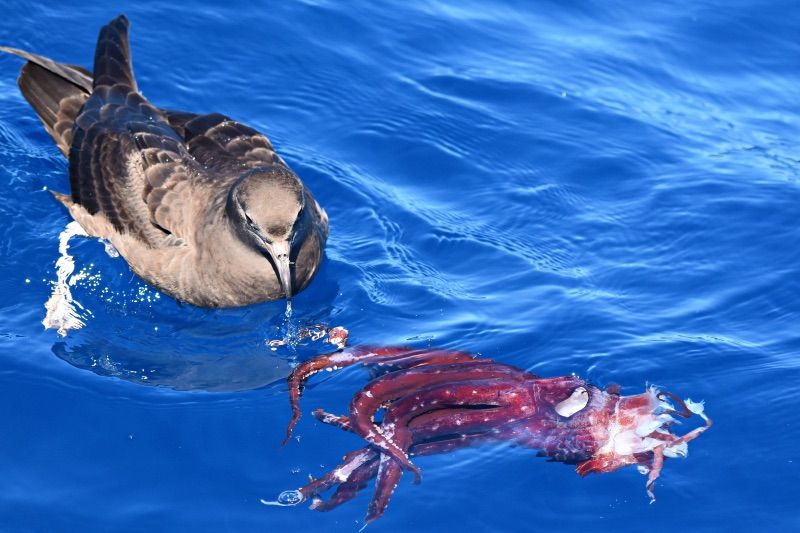The stranding event that took place at Cheynes Beach in Western Australia this week of nearly one hundred Pilot Whales has left many wondering why this has happened. Whales and dolphins live their lives in a marine environment and when they come ashore this is called stranding or beaching. The dangers in a cetacean (whale or dolphin) stranding is overheating and pressure on internal organs. Cetaceans are very good at retaining heat with a thick blubber layer insulating them and preventing excessive heat loss in a marine environment. During stranding the whales are removed from their marine home and are no longer able to regulate their core body temperature as they usually do and this leads to overheating which can be fatal. The below graph shows the process of cooling and maintaining core body temperature in normal circumstances but once outside of their marine home they are no longer able to efficiently cool themselves.

The second danger is bodyweight and no longer having buoyancy once stranded, the weight of their body can damage internal organs and cause difficulties in breathing. The combination of heat and weight can cause even perfectly healthy whales to struggle in surviving a stranding event. Pilot Whales strand more frequently than many other species and due to living in large family pods it is always a difficult rescue situation with so many individuals requiring assistance. The reason why Pilot Whales strand can be varied and it does depend on the population you are working with and nearby environmental factors. Pilot Whales use the magnetic field as part of their navigation and appear to be extremely sensitive to any changes in the magnetic field, more so than other species. It creates a challenging situation with offshore, deep water specialists travelling in very large pods finding themselves disoriented and unsure in shallow waters.
Looking into the stranding event that has taken place on Cheynes Beach we look at all factors that could have caused the situation. Also, understanding the particular population that have stranded is also very important and provides further information on what could have caused the event. The population of Pilot Whales observed in the waters off the southern Australian coastline including Bremer Bay and Albany are not well studied. During our Bremer Bay Orca season we have the opportunity of working with the population and learning more and more about them every year. It makes this stranding event even more difficult as it is highly likely that we have worked with these particular individuals at some point in the past. The below factors have been raised as to why they did strand at Cheynes Beach and we have included the documented information and footage to explain more about this particular population.
Orca or Sharks
Orca are the apex predators of our ocean and have been known to attack Pilot Whales in other areas of the world. During our time working with the Pilot Whales and Orca of Bremer Bay we have not observed any attacks or overtly aggressive attempts to kill or harm each other between either of the species. Interestingly the behaviour observed ranges from dominant to passive depending on what is unfolding on that particular day. During feeding events the Pilot Whales can travel vast distances to approach the location of the hunt and if it is a squid kill the Pilot Whales have been observed trying to steal the squid from the Orca. The most interesting interaction is when the Pilot Whales charge the Orca and it has been observed on many occasions that the Orca will leave the area and the Pilot Whales will win that interaction. Later on in the day once the Orca have regrouped and joined with other Orca pods they can return and push the Pilot Whales back out of the area once again.
The interactions can be boisterous and dominant but it is always the Pilot Whales who are the aggressors towards the Orca due to their much larger pod size and overt confidence, the Orca respect them and tend to move out of the area once Pilot Whales have arrived. During foraging swims we have also observed both Pilot Whales and Orca swimming alongside each other over many kilometres in search of food. The regularity of these interactions and behaviour between the two species does not indicate that there was any reason why the Pilot Whales at Cheynes Beach found themselves there because of Orca. Pilot Whales of Bremer Bay have not been observed with shark bite wounds or similar scarring, they have also never displayed nervous or flight behaviour when sharks have been in the area. Similar to the Orca situation the Pilot Whales have been observed pursuing sharks to chase them out of the area especially when there are newborn calves in the family pod or food in the area. The video below documents the approach of the Pilot Whales after the Orca made a successful kill of a Giant Squid, very cheeky indeed!
Vessel Noise
The southern stretch of coastline the Pilot Whales live and hunt in is very isolated but still has regular vessel traffic. Shipping vessels will often pass by areas that Pilot Whales are hunting in and we have seen on a number of occasions close interactions between Pilot Whales and vessels. Bremer Bay Orca season 2023 observed a successful Cuvier Beaked Whale hunt by the Orca and throughout the lengthy hunt a large shipping vessel was moving past the area.
The travelling vessel did not disturb the hunt or prevent the Pilot Whales from listening in to the commotion as they came charging in towards the end of the hunt as they once again investigated the Orca activities. Pilot Whales have also approached our vessel during tours and enjoy socialising with us and also around our vessel displaying a great intelligence and curiosity. Although they are an offshore species they do show great confidence and interest towards vessels, thankfully the vessels working in these waters are here for short periods of time and we do not see any disturbance from the vessel noise towards the Pilot Whales.

Health
Pilot Whales live long lives (40 to 60 years) and are extremely family orientated throughout their lifetime. Pod members can become unwell especially in older age and this is when a problem can arise as sometimes when unwell they will seek out shallow waters. The family will not leave that pod members side and will follow them for support and comfort, should the unwell pod member approach shallow waters then the entire family pod can be put in danger.
Birthing troubles can also be another problem, should females move closer to the coastline to give birth to their calves in slightly warmer waters and there are any birthing difficulties then the entire family can get into trouble easily. Pilot Whales are supportive and caring towards their family and will do all they can to stay together, even if that means following them into a shallow and navigationally challenging environment.

Food
Prey can be hard to find on certain days and for Pilot Whales they are lead by elders of the family who have many years of experience and knowledge. Finding food can sometimes mean visiting different areas at different times of the year which may put them in areas that are outside of their usual hunting grounds. Shallow waters can provide meal opportunities or better birthing areas which are all factors as to why they can be encouraged to move in closer to the coastline. Due to Pilot Whales being offshore specialists they are comfortable navigating in deep, 1000+ meter waters and find it out of their comfort zone navigating through shallow coastal waters where the leading pod members can become disoriented or confused.

Solar Flare
The power of the sun is extraordinary and there are certain events known as solar storms which send subatomic particles hurtling towards earth almost as fast as the speed of light. The powerful gases surrounding the sun create a magnetic field and when these magnetic fields become twisted and connected we see powerful solar explosions known as solar flares. This solar activity has an enormous influence on earth and can affect satellites, GPS navigation and the earths magnetic field. The particles that are released from a coronal mass ejection (CME) from these solar flares are what trigger the northern and southern lights or aurora.
The affects on whales has only recently been discovered but as we look further into these events we can see the connection through a very unique character… the pigeon. Homing pigeons are world renowned for their ability to navigate back to their home with one individual flying from France to Vietnam, that is a distance of over 11,000 kilometres! They are believed to achieve this through their use of the earths magnetic field and when there is a powerful solar flare the magnetic field is distorted. The natural GPS for these pigeons is now affected and even by using their sense of smell and sound they are still limited to finding their way back home and can become disoriented.
Whales and dolphins also travel thousands of kilometres throughout the year and most often we see it is the oceanic species who become stranded most frequently. The way of navigation for these ocean nomads needs to be better understood but the correlation of using magnetic fields for navigation is highly probable. During these long journeys their migration path, ill health or prey may bring them closer to the coastlines. Could the unfortunate timing of a solar storm affect their navigation at a crucial moment and send them in the wrong direction. Finding themselves in shallow waters, species such as Pilot Whales become disorientated and their navigational like sonar appears to stop working correctly. Further information on solar flares can be found here.
Why Did They Strand?
The reason why a stranding event takes place can be a combination of the above or simply a solar flare that has disorientated the leaders of that particular family pod at a very bad time in their journey past a particular tricky area of coastline. The footage captured by drone of the family huddling together very closely prior to stranding is important information to learn from. During our time with them out in the Bremer Canyons we have observed the same behaviour in a social situation as pods have met for the first time after travelling over two kilometres to meet each other. Grouping together closely and spy hoping to get their bearings the family was relaxed and we could see a wonderful and intense communication amongst the pod members.
Observing the drone footage from Cheynes Beach we can see the same grouping/huddling behaviour but the body language amongst this family is concerned, disorientated and distressed. Understandably they are in a very uncomfortable situation and waiting on guidance from the elders of the family pod. Keeping close and waiting each pod members is working to maintain their position and unfortunately as the footage shows the lead animals made their way towards the beach and every other pod member willingly followed. Family is everything to Pilot Whales and in these situations they will not leave pod members behind which is why even after recovery from the beach they will strand again as they hear the calls of pod members. Also, without elders of the family leading them younger pod members do not have the experience and can find themselves returning back to the beach mimicking what they did previously when following elder pod members that were disoriented or unwell.
Stranding events have occurred throughout history and our focus should be directed to ways of assisting these pods regaining their bearings and improving rescue procedures. Working with such large creatures in remote locations is extremely challenging with specialised equipment needing to be designed and trialled. A purse seine style pen similar to what is used for tuna farms could be designed to create a controllable enclosure which individual whales can be moved into before being slowly moved further out to sea and away from the confusing navigational problems with shallow environments. Every rescue situation will be different with some locations more isolated than others and whales responding differently to rescue attempts.
All we can do is try just as all the volunteers did over the last few days to give these whales every chance possible of survival. Learning lessons from these stranding events is important as it is a situation that has been observed right throughout history especially when solar flares, health and navigational disorientation are involved and outside of anyones control. Designing equipment to better manage the movement of these whales once returned to sea would be a great next step. It will be a challenge but nothing that cannot be overcome without effort and dedication to continually improve how we can rescue these Pilot Whales and others in future events. The way of life of all cetaceans is very much outside of this world at certain times and we must appreciate this and think outside the box when investigating the reasons behind their decisions.






